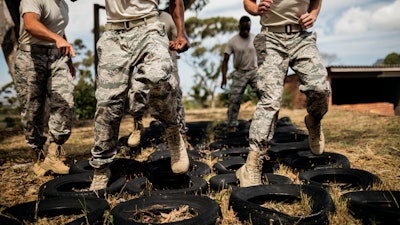
The new Army Combat Fitness Test (ACFT), which replaced the Army Physical Fitness Test (APFT), was officially implemented on Oct. 1 for all active-duty members. The test will be ordered for all National Guard members as of April 1, 2023, and on April 1, 2024, for the National Reserves. The new ACFT was designed to ensure soldiers are ready to perform combat tasks, reduce preventable injuries and promote a culture of fitness throughout the Army.
“This is probably the most studied, talked-about, reviewed and scrutinized fitness test, probably in the history of the world — certainly more than our sister countries and services,” Michael McGurk, who oversaw the development for the ACFT, recently told Military.com.
That might not be hyperbole. This was the Army’s third attempt at overhauling the test, and some soldiers initially panned the new test as being overly complicated, while others said it wasn’t fair to women and older soldiers. That latter criticism was later supported in a study by RAND Corp., which analyzed results from testing using the ACFT and found differences in pass rates for women (women passed at lower rates than men), by age (with older soldiers passing at lower rates), across components (with the U.S. Army Reserve and the Army National Guard lagging behind the regular Army), and across military occupational specialties and areas of concentration. The test remains the same for all, however, and scoring is scaled depending on gender, as well as age.
The new ACFT is believed to be much more complicated than the APFT, which was used since 1980. The APFT only involved three events — pushups, situps and a timed two-mile run — but that test was criticized for being too simple. The war in Afghanistan and major deployments to the country’s mountainous terrain was at least one catalyst for a new emphasis on fitness and for developing a better way of assessing soldiers’ abilities.
“I had a young captain who influenced me a lot in terms of thinking, who spent seven months in the Korengal Valley [Afghanistan], and we talked a lot about taking direct fire every single day, every time he stepped out of the chopper or wherever he was,” Whitfield East, an Army physiologist who helped develop the ACFT, told Military.com. “It was a rigorous environment.”
How difficult is it to pass the new test? Obviously, that depends on how physically fit a soldier happens to be, and in what manner. Some soldiers may breeze through the two-mile run but have difficulty with the muscular endurance needed to excel at the Sprint-Drag-Carry event. The test was designed with the aim of producing well-rounded soldiers who have both strength and stamina.
“What is different is that this is a much better test, right?” said Brig. Gen. Scott Naumann at a March 2021 military roundtable. “It’s much more comprehensive. It looks at all different aspects of fitness, from endurance to, you know, strength to aerobic capacity. So, in that regard, it’s a much better test.”
The Six Steps of the ACFT
The ACFT evaluates a soldier’s physical and mental abilities every year, starting at basic training for enlisted soldiers and during initial training for those commissioning as officers. Soldiers take the ACFT several times a year, with scores recorded twice a year for an active-duty soldier in the Army, or once a year for any members of the Army Reserve and Army National Guard.
As previously mentioned, scoring for the test uses different requirements for gender and age. Soldiers need to score a minimum of 60 points on each of the six events in order to pass the ACFT, with a minimum total score of 360. The maximum score per event is 100 points, with a total maximum score of 600. Here’s a look at the six events that make up the test:
3 Repetition Maximum Deadlift
Soldiers lift the maximum weight they are capable of lifting three times, using a 60-pound hex bar and plates. The event assesses a soldier’s muscular strength, balance and flexibility.
Standing Power Throw
Soldiers throw a 10-pound medicine ball backward and overhead as far as possible. This event assesses a soldier’s physical power, balance and flexibility.
Hand Release Pushup
Soldiers complete as many hand-release pushups as possible in two minutes, using the proper technique. This event assesses a soldier’s muscular endurance.
Sprint-Drag-Carry
Soldiers do 50-meter shuttles (sprint, drag, lateral, carry, sprint) as fast as possible using two 40-pound kettlebells and a 90-pound sled. This event assesses a soldier’s muscular endurance.
Plank
During this event, soldiers maintain a plank for as long as possible. This event assesses a soldier’s muscular endurance.
Two-Mile Run
Soldiers complete a two-mile run as fast as they can. This event assesses a soldier’s aerobic endurance.







































